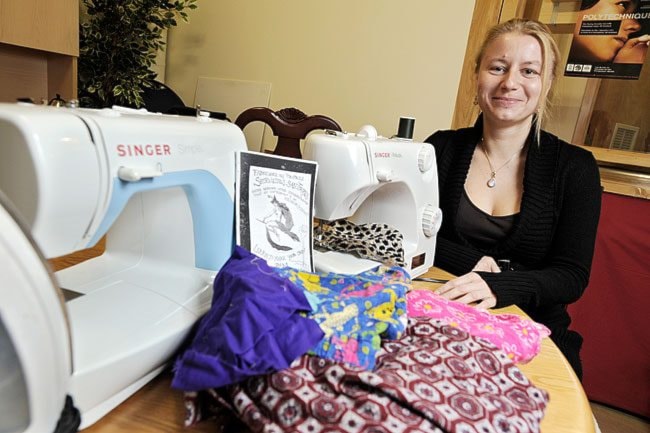Throughout her lifetime, a woman will use a minimum of 6,300 pads or tampons.
That’s approximately three pads or tampons per day, for approximately five days a month, 12 months per year, for the approximately 35 years a woman menstruates.
And that’s the minimum.
All women are different, but it’s likely most women will use more than 6,300 pads or tampons in a lifetime.
Now multiply that number by the Earth’s female population.
“For the environment, it’s huge,” said Ketsia Houde, the executive director for Les EssentiELLES. “We don’t need to use all these products that you have to throw in the garbage.”
Pads, especially, are plastic-based, just like diapers. They are not biodegradable.
“Plus, tampons, are full of chemicals that are really, really toxic for women, and they are only traces, but if you use them every month for 35 years, the traces may become more than traces,” Houde added.
Now, on top of that, add the financial costs.
Prices for pads and tampons across the territory vary.
This week, the cheapest tampons you could buy at the General Store in Dawson City were in a $5.29 box of 18. The cheapest pads were a pack of 18 for $4.59.
At the Tatchun General Store in Carmacks, the cheapest pads were a package of 36 for $9.96. The cheapest tampons were a box of 20 for $5.79.
In Old Crow, at the only store, the cheapest tampons were a box of 18 for $7.89 and a package of 18 pads were the cheapest at $7.59.
And finally, in Whitehorse, at Shoppers Drug Mart, the variety of pads in packages ranging from 50, to 32, to 28, to 14 cost between $8.99 and $3.49. The tampons, in packages of 40, to 26, to 18, ranged from $5.99 to $19.99.
So now, do the math.
If a Whitehorse woman uses a minimum of 6,300 pads or tampons in her life, she will spend an absolute minimum of
$1,132.74 on pads or $1,415.93 on tampons. At the other extreme, an Old Crow woman would spend $2,761.50 on tampons or $2,656.50 on pads.
That’s a lot of dough, for a lot of garbage.
But there are other options.
This Saturday, Les EssentiElles is staging its biennial workshop, teaching women how to make their own, reusable, feminine pads.
The movement for a more eco-friendly, affordable and healthy option for women has been spreading internationally for years.
It gained widespread and commercial success with the release of the “Diva Cup” or “Keeper,” both reusable, rubber cups - an idea that has existed for over 75 years.
Les EssentiELLES has been offering the three-hour course on homemade pads for five years.
It’s $5, all the materials are recycled and each woman walks away with as many pads as they can sew (usually around two or three).
The concept is easy: replace the toxic and perfumed plastic with cotton or flannel.
Then wash the cloth. Some women use water and some vinegar, others just wash them in the shower with the same soap they use on their bodies, said Houde.
Reusable pads are also not a new concept.
Houde started using the self-made pads in university 10 years ago and she still remembers her mother’s reaction when she told her about them.
Between rolling eyes and breathy sighs, Houde’s mother recounted how happy she and her girlfriends were when the disposable pads became available.
“Why do you do that?” her mother asked, lamenting about the days she and her own mother had to spend washing pads and baby diapers.
“You really need an environmental conscience to do this,” said Houde.
And while she is still greeted with contorted faces and gasps of “gross” when she tells other women about it, especially younger girls, for Houde, the reusable, cotton pads provided more solutions than problems.
Like many women, Houde was allergic to the plastics, perfumes and dyes contained in most brand-name pads and tampons.
“The doctors didn’t know what to do,” she said. “When I stopped using them and started using the cotton pads, all my problems disappeared.”
There are biodegradable and non-perfume brands of pads and tampons available, but they are usually twice the cost of regular pads and tampons, added Houde.
You don’t need to be an expert seamstress to make your own pads, said Houde, laughing at the sight of the first few she made - making them was the first time she had ever used a sewing machine.
And the workshop allows women to come together and talk about their experiences, she said.
For example, during the workshop, Houde always brings up how to approach the topic with boyfriends and roommates who share bathroom space.
“It’s sharing a way of doing things - a way of living,” she said. “It’s giving women another option to deal with their health.”
And there is a sense of empowerment that comes with it, said Houde.
“In the marketing industry it’s always about hiding,” she said, pointing out the constant competition to make the smallest, least noticeable pads and tampons so “no one has to know.”
“It’s ugly, it’s shameful, it’s all of that.
“Using a Diva Cup, for me, helped me really take control of my menstruation, my periods. Seeing that it’s fine, it’s clean, it’s just blood. There’s nothing bad there.
“It’s not dirty - that’s the big thing. And having to wash your pads you realize that.
“It’s not dirty, it’s just blood.”
The workshop will be held in French, from 1 to 4 p.m. this Saturday at the Centre de la Francophonie. But if you don’t understand French, keep your eyes open for upcoming, English workshops being offered at the Victoria Faulkner Women’s Shelter.
Les EssentiELLES will also be selling keepers and moon cups (like the Diva Cup) and pstyles (which allow women to pee standing up) as a fundraiser on Saturday as well.
Contact Roxanne Stasyszyn at
roxannes@yukon-news.com
